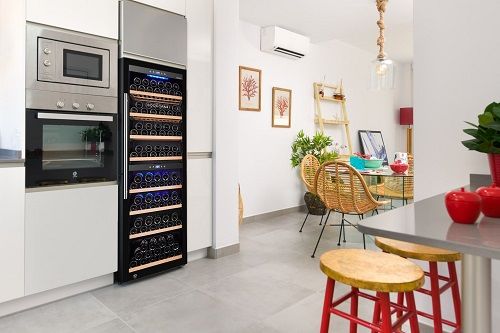Wine storage rack under the stairs is an excellent home improvement idea if you enjoy wine. Making room for storing wine is simple. You will be fine with establishing a chic wine cellar if you have available space, such as a basement fitted with wine coolers. To prevent wines from ageing past their use-by dates. And occasionally, some wine collectors need to be reminded that wine is meant to be consumed!

Wine collecting
A wine cellar and wine collecting aren’t just for the affluent. Numerous individuals of various socioeconomic levels collect wine. Knowing that your wine collection is secure when you have a tiny wine cellar allows you to sleep soundly. Another benefit of having a wine cellar inside your house is convenience. You may easily access your own personal collection of wine bottles thanks to this, which eliminates the need for frequent buying. Make sure it is at the best wine cooler temperature. For such an occasion, there will always be something unique waiting for you.
Art is in the eye of the beholder.
Sometimes even rational individuals become affected by wine. They are overcome by the want to spend a lot of money on a collection of bottles that will age over their lives. They compete for smart or uncommon wines that are being sold as futures, and they pay for them long before they are really delivered. They might also purchase vintage wines at auction to fill up any gaps in their collections. Only purchase wine as an investment. In any event, wine prices fluctuate both upward and downward. However, like all forms of collecting, it may be very enjoyable and costs much less than collecting, say, works of art. It is necessary to maintain a reasonable level of records, such as those provided by online cellar management systems.
The right temperature
Due to the fact that evolution is sped up at higher temperatures, the exact temperature at which wine is stored is also significant. When temperatures drop below -4 °C (25 °F), the lightest wines freeze and can fatally push corks out of bottlenecks, so precautions should be taken. Above 30 °C (86 °F), a wine’s more volatile ingredients may boil off irreversibly, changing the colour and clarity. In general, the best temperature for wine storage is generally between 10 and 15 °C (50 and 59 °F). Still, wine stored between 15 and 20 °C (59 and 68 °F) won’t suffer much damage as long as the temperature doesn’t change too much, causing the wine to expand and contract quickly.
You have the ideal location for securely storing your wine so that it will taste exactly the same when it is served and opened. If you don’t have the ideal storage space, don’t worry too much—almost anyone does! Not all of the aforementioned considerations are crucial for short- to medium-term storage, and as long as you can adequately regulate temperature and light, you should feel confident preserving wine for at least a year or two without any negative effects.